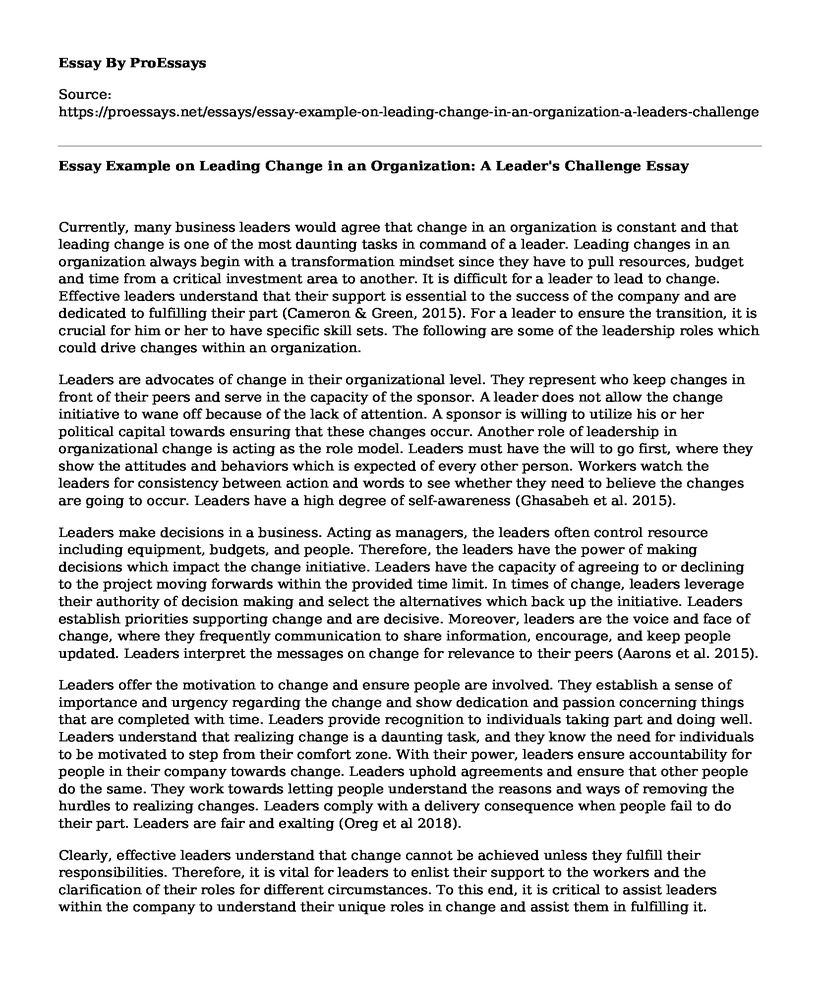Currently, many business leaders would agree that change in an organization is constant and that leading change is one of the most daunting tasks in command of a leader. Leading changes in an organization always begin with a transformation mindset since they have to pull resources, budget and time from a critical investment area to another. It is difficult for a leader to lead to change. Effective leaders understand that their support is essential to the success of the company and are dedicated to fulfilling their part (Cameron & Green, 2015). For a leader to ensure the transition, it is crucial for him or her to have specific skill sets. The following are some of the leadership roles which could drive changes within an organization.
Leaders are advocates of change in their organizational level. They represent who keep changes in front of their peers and serve in the capacity of the sponsor. A leader does not allow the change initiative to wane off because of the lack of attention. A sponsor is willing to utilize his or her political capital towards ensuring that these changes occur. Another role of leadership in organizational change is acting as the role model. Leaders must have the will to go first, where they show the attitudes and behaviors which is expected of every other person. Workers watch the leaders for consistency between action and words to see whether they need to believe the changes are going to occur. Leaders have a high degree of self-awareness (Ghasabeh et al. 2015).
Leaders make decisions in a business. Acting as managers, the leaders often control resource including equipment, budgets, and people. Therefore, the leaders have the power of making decisions which impact the change initiative. Leaders have the capacity of agreeing to or declining to the project moving forwards within the provided time limit. In times of change, leaders leverage their authority of decision making and select the alternatives which back up the initiative. Leaders establish priorities supporting change and are decisive. Moreover, leaders are the voice and face of change, where they frequently communication to share information, encourage, and keep people updated. Leaders interpret the messages on change for relevance to their peers (Aarons et al. 2015).
Leaders offer the motivation to change and ensure people are involved. They establish a sense of importance and urgency regarding the change and show dedication and passion concerning things that are completed with time. Leaders provide recognition to individuals taking part and doing well. Leaders understand that realizing change is a daunting task, and they know the need for individuals to be motivated to step from their comfort zone. With their power, leaders ensure accountability for people in their company towards change. Leaders uphold agreements and ensure that other people do the same. They work towards letting people understand the reasons and ways of removing the hurdles to realizing changes. Leaders comply with a delivery consequence when people fail to do their part. Leaders are fair and exalting (Oreg et al 2018).
Clearly, effective leaders understand that change cannot be achieved unless they fulfill their responsibilities. Therefore, it is vital for leaders to enlist their support to the workers and the clarification of their roles for different circumstances. To this end, it is critical to assist leaders within the company to understand their unique roles in change and assist them in fulfilling it.
References
Aarons, G. A., Ehrhart, M. G., Farahnak, L. R., & Hurlburt, M. S. (2015). Leadership and organizational change for implementation (LOCI): a randomized mixed method pilot study of a leadership and organization development intervention for evidence-based practice implementation. Implementation Science, 10(1), 11.
Cameron, E., & Green, M. (2015). Making sense of change management: A complete guide to the models, tools, and techniques of organizational change. Kogan Page Publishers.
Ghasabeh, M. S., Soosay, C., & Reaiche, C. (2015). The emerging role of transformational leadership. The Journal of Developing Areas, 49(6), 459-467.
Oreg, S., Bartunek, J. M., Lee, G., & Do, B. (2018). An affect-based model of recipients' responses to organizational change events. Academy of Management Review, 43(1), 65-86.
Cite this page
Essay Example on Leading Change in an Organization: A Leader's Challenge. (2022, Dec 27). Retrieved from https://proessays.net/essays/essay-example-on-leading-change-in-an-organization-a-leaders-challenge
If you are the original author of this essay and no longer wish to have it published on the ProEssays website, please click below to request its removal:
- PM Leadership Essay
- Meals on Wheels Organization Planning Paper Example
- Leadership Analysis: Martin Luther King Jr. Essay
- Response Paper: Industrial Crisis
- Essay on Contingency Theory: No One-Size-Fits-All Leadership and Decision-Making
- Essay on Gaining Control of Your Free Time: Laura Vanderkam
- Leaders: Improve Communication Through Active Listening & Nonverbal Cues - Essay Sample







